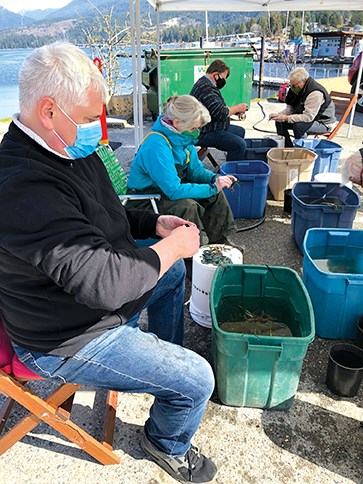It was a sunny day March 31, and COVID-spaced and masked volunteers chatted while placing washers on newly harvested eelgrass shoots. The washers function as anchors for the eelgrass shoots, which have been harvested from healthy donor beds in Porpoise Bay, and will be replanted in damaged areas that are good candidates for replanting.
Eelgrass restoration work took place March 30 and 31, with 1,200 eelgrass shoots planted in a 14-by-5-metre area located between the Public Dock and MacKenzie’s Marina in Porpoise Bay.
To prepare for this, a 24-foot derelict sailboat which had been submerged for over 20 years had to be removed from amidst a healthy eelgrass bed, along with associated debris (netting, metal walkways, engine, plus a skiff).
The Dead Boat Removal Society, with financial support from the shíshálh Nation, commissioned MacKenzie Sea Services, which did the removals earlier in March.
This project was over two years in the planning, and is one of the many restoration projects carried out by SeaChange Marine Conservation Society (seachangesociety.com).
Funded by the Coastal Restoration Fund for five years, the Salish Sea Nearshore Habitat Restoration Project is in its final year.
There have been eelgrass transplants in Lamb’s Bay, and a derelict dock off the Harbour Air seaplane float was removed because it was located over a healthy eelgrass bed, shading the eelgrass and destroying it with the movement of anchoring chain over the substrate. This enabled replanting of the damaged area in July 2020. Monitoring of areas is done every six months for five years following eelgrass restoration.
This project spans Howe Sound, Burrard Inlet, Gulf Islands, and Sechelt Inlet, with regional coordinators in each area. Without the support of the shíshálh Nation, and the time and effort donated by the many volunteers over the past years, this project would not have been possible.
Dianne Sanford is the coordinator for Sechelt Inlet, and can be contacted at [email protected].



